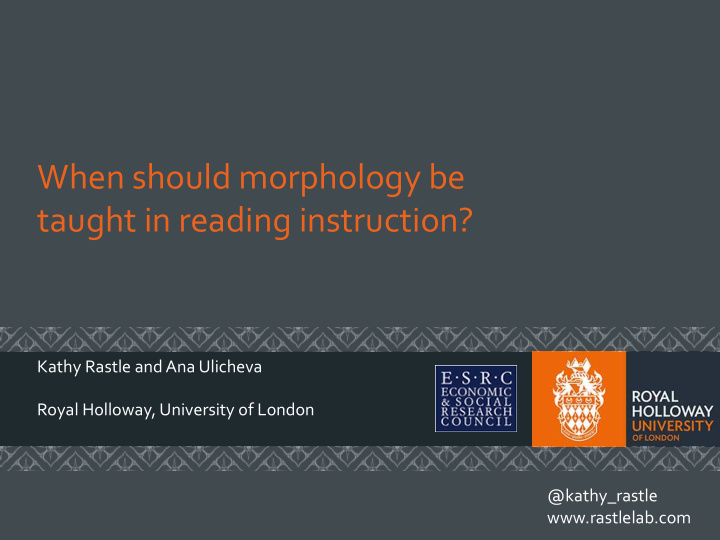



When should morphology be taught in reading instruction? Kathy Rastle and Ana Ulicheva Royal Holloway, University of London @kathy_rastle www.rastlelab.com
Regularities in English writing Spelling-sound (phonic) regularities cab, pat, act, sad church, chunk, teach, chat Spelling-meaning (morphological) regularities banker, teacher, builder, gardener cleaner, unclean, cleanliness, cleanly
Place of morphology in reading Sound develop, develops, developing, Meaning Spelling developed, developer(s), • Item-level “orthographic learning” (e.g. Nation, 2017) undeveloped, • Morphology dramatically reduces scale of the undevelopable, learning challenge developable, • development(s), Average 20 year old – 71,000 word forms -> 42,000 lemmas -> 11,100 base words (Brysbaert et al., 2016) developmental, developmentally, • Dramatically simplifies spelling antidevelopment, redevelop,
Morphological cues to meaning Trade-off between phonological regularity and morphological regularity • One spelling for different sounds (stems: magic, magician) • Several spellings for one sound (affixes: e.g. –less, – ical); allows particular spellings to become reserved for communicating particular meanings Spellings communicate meaningful information that is not present in the spoken forms of words
Morphological cues to meaning Our reading and spelling experiments show that skilled readers 1. Rapidly access meaningful information encoded in spellings 2. Use different spellings to communicate intended meaning [sed ʒ n ɪ s] sedgeness The presentation recognised the impressive ……………………. of the protestors sedgeniss The mourners began to sadly …………………………….. as the coffin disappeared
Morphological cues to meaning Our analysis of English spelling has yielded 22 “rules” that guide the spelling of word endings Number of Sound as in exceptions frequency frequency spelling Critical Spelling Critical Possible Sound Rule Spelling Rule spellings for Examples rule exceptions sound If noun, crosseyed, 74 1 pesticide, chloride formaldehyde use "ide" a ɪ d decide certified, ide 112 If verb, coincide, decide, formaldehyde 28 0 - use "ide" abide e ɪ d parade milkmaid, aide, If verb, upgrade, invade, 32 4 ade 85 braid, upbraid limeade, suede use "ade" pervade
When / how should morphology be taught? • Moderate effect of morphological instruction (d=.32). • Impacts on decoding, spelling, phonological awareness, morphological knowledge, vocabulary; but not reading comprehension or fluency measures. • But included K-12, variety of interventions, variety of controls, so hard to draw specific conclusions for instruction.
Bowers & Bowers (2017) argument • Theoretical and empirical problems with phonics • English writing is morpho-phonetic • Instruction should target interrelations between orthography, phonology, morphology, etymology from the beginning • Structured Word Inquiry
Rastle & Taylor (2018) response • Morphology is important but not so much in the initial period of reading instruction • Analysis of words encountered in first year of reading instruction • 81% spelling-sound regular and 80% single morphemes (remainder usually inflections) • Instruction needs to be backed up by text experience • Phonics first, then morphology
Place of morphology in reading Sound Meaning Spelling • Spelling-meaning (ventral) pathway still developing into adolescence (Ben Shachar et al., 2011) • Major morphological effects not visible until late adolescence (Dawson et al., 2017; in preparation) • Instruction + massive text experience; part of becoming a skilled reader
Resources
Some bedtime reading …
Thank you!
Recommend
More recommend